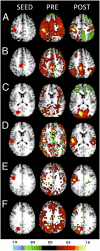Resting-state activity in development and maintenance of normal brain function
- PMID: 21709227
- PMCID: PMC3136307
- DOI: 10.1073/pnas.1109144108
Resting-state activity in development and maintenance of normal brain function
Abstract
One of the most intriguing recent discoveries concerning brain function is that intrinsic neuronal activity manifests as spontaneous fluctuations of the blood oxygen level-dependent (BOLD) functional MRI signal. These BOLD fluctuations exhibit temporal synchrony within widely distributed brain regions known as resting-state networks. Resting-state networks are present in the waking state, during sleep, and under general anesthesia, suggesting that spontaneous neuronal activity plays a fundamental role in brain function. Despite its ubiquitous presence, the physiological role of correlated, spontaneous neuronal activity remains poorly understood. One hypothesis is that this activity is critical for the development of synaptic connections and maintenance of synaptic homeostasis. We had a unique opportunity to test this hypothesis in a 5-y-old boy with severe epileptic encephalopathy. The child developed marked neurologic dysfunction in association with a seizure disorder, resulting in a 1-y period of behavioral regression and progressive loss of developmental milestones. His EEG showed a markedly abnormal pattern of high-amplitude, disorganized slow activity with frequent generalized and multifocal epileptiform discharges. Resting-state functional connectivity MRI showed reduced BOLD fluctuations and a pervasive lack of normal connectivity. The child underwent successful corpus callosotomy surgery for treatment of drop seizures. Postoperatively, the patient's behavior returned to baseline, and he resumed development of new skills. The waking EEG revealed a normal background, and functional connectivity MRI demonstrated restoration of functional connectivity architecture. These results provide evidence that intrinsic, coherent neuronal signaling may be essential to the development and maintenance of the brain's functional organization.
Conflict of interest statement
The authors declare no conflict of interest.
Figures




References
-
- Biswal B, Yetkin FZ, Haughton VM, Hyde JS. Functional connectivity in the motor cortex of resting human brain using echo-planar MRI. Magn Reson Med. 1995;34:537–541. - PubMed
Publication types
MeSH terms
Substances
Supplementary concepts
Grants and funding
LinkOut - more resources
Full Text Sources
Other Literature Sources

